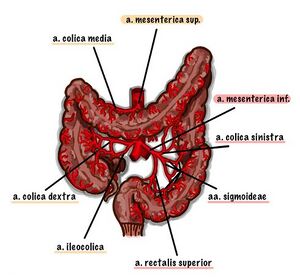Basic symptoms of diseases of the esophagus, stomach and intestines
Esophagus[edit | edit source]
Dysphagia is a disorder of the passage of food during the swallowing act, which is associated with a transient feeling of pressure and a feeling of being stuck or stuck. It occurs in organic diseases (first passage of solid bites) and functional disorders (paradoxically, the passage of liquid food first). Congestion in the esophagus leads to a feeling of pressure and fullness at the level of the lower end of the sternum. In patients over 45 years of age, dysphagia is most often caused by peptic esophagitis or esophageal achalasia (a disorder of cardiac relaxation during the passage of food). Oesophageal cancer and peptic esophagitis are the most common causes in patients over 45 years of age.
Narrowing of the esophagus in the neck section is accompanied by a cough, narrowing in the chest section is accompanied by a feeling of heavy breathing.
Odynophagia is a painful swallow that accompanies inflammatory or viral damage to the mucosa or increased wall tension during spasms.
Another symptom is regurgitation of digested food in the mouth without nausea and vomiting. Heartburn is a common manifestation .
Stomach[edit | edit source]
Symptoms of gastric dyspepsia include a feeling of fullness and pressure in the abdomen, belching, heartburn, regurgitation, anorexia, nausea, vomiting and various other symptoms such as bitterness in the mouth, dry mouth (xerostomia), coated tongue, bad breath or hiccup.
Stomach disease is most manifested as abdominal pain. Abdominal pain can have different origins. Any abdominal pain should be examined so that we can rule out a sudden abdominal event with certainty . Stomach pain is projected into the abdomen.
Meteorism means increased gas production.
Another symptom may be bleeding. Melena is digested blood in the stool, it arises during bleeding from the stomach or duodenum. Haematemesis means vomiting of the blood, for example after perforation of the esophageal varices. Enterorrhea indicates the presence of clear blood in the stool, the blood comes from the distal sections of the digestive tract.
We can also observe ascites, a typical symptom of liver disease.
Intestines[edit | edit source]
Intestinal dyspepsia manifests as abdominal cramps, flatulence (increased gut gas in the rectum), bloating, constipation, or diarrhea.
Links[edit | edit source]
Related articles[edit | edit source]
References[edit | edit source]
- CHROBÁK, Ladislav, et al. Propedeutika vnitřního lékařství. 2. vydání. Grada, 2003. ISBN 80-247-0609-1.

